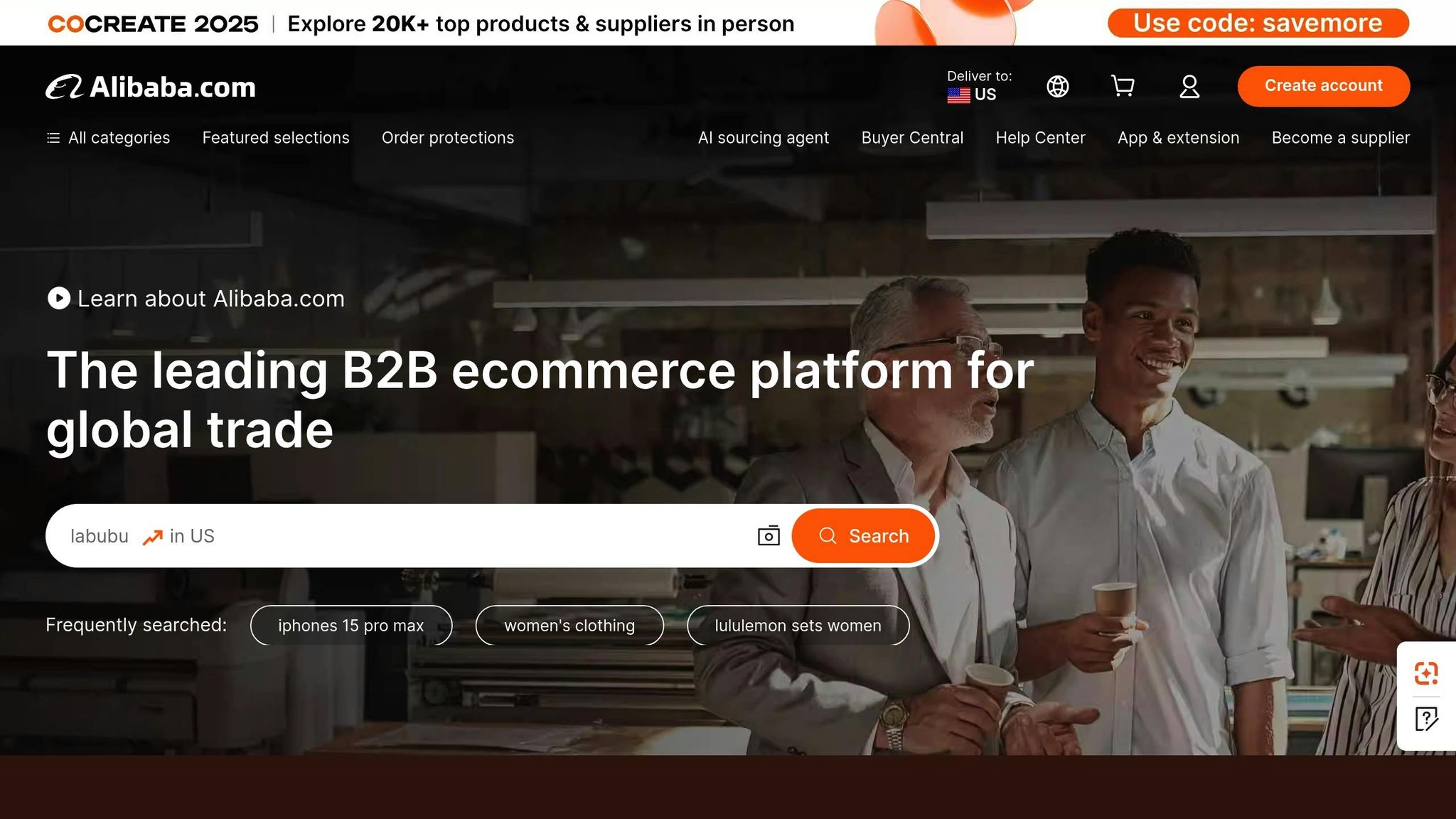AI in Cross-Border Sales: Key Benefits
Explore how AI enhances cross-border sales through personalized interactions, cost savings, and improved multilingual communication.

53% of customers feel rushed by outdated personalization methods, leading to lower satisfaction and fewer repeat purchases. Businesses expanding internationally face challenges like language barriers, regional preferences, and inconsistent customer interactions, which directly impact revenue growth. With cross-border e-commerce growing 219% faster than overall e-commerce, companies must rethink their strategies to keep pace with evolving global markets.
In this article, you'll discover:
- How AI tools like RINDA increase conversion rates by up to 20% by personalizing global sales interactions.
- The measurable cost savings AI delivers, including a 15% reduction in operational expenses.
- Practical ways AI simplifies multilingual communication, addressing the needs of 75% of consumers who prefer native-language interactions.
With global sales becoming increasingly complex, leveraging AI provides a competitive edge. Companies already using AI report a 50% increase in leads and appointments, proving its value in addressing international challenges. Read on to explore how your business can implement these insights to drive growth and efficiency in an interconnected marketplace.
Alibaba.com Taps AI to Lower International Merchant Barriers

1. Standard Personalization Methods
Traditional personalization in cross-border sales often relies on segmentation and rule-based systems to create tailored experiences for international customers. While these methods form the backbone of customer-focused strategies, they fall short when addressing the complexities of global markets. For instance, over 70% of consumers expect brands to respond immediately on social media, but these standard approaches often fail to deliver real-time, region-specific interactions.
Companies like Netflix, Airbnb, and Coca-Cola’s “Share a Coke” campaign have demonstrated the power of localization. However, such successes require significant manual effort, making them difficult to replicate at a global scale. These methods face challenges in keeping pace with the demands of large and dynamic international markets.
Scalability
As businesses expand into new markets, the inefficiencies of traditional personalization methods become more apparent. These systems rely heavily on manual processes, which limit their ability to scale. For example, traditional e-commerce methods operate at just 60–70% efficiency, largely due to the constant human oversight required. This lack of scalability makes it difficult for businesses to adapt quickly to changing market conditions.
The limitations are particularly noticeable when serving diverse customer bases. Broad-based approaches that fail to address individual preferences often result in low conversion rates - typically around 2–3% for companies using traditional pricing methods. This underscores the need for more nuanced strategies that can cater to varied customer expectations globally.
Response to Regional Trends
Traditional personalization also struggles to keep up with regional sales trends and cultural preferences. For example, while American shoppers tend to value detailed customer reviews, Chinese consumers often prioritize influencer recommendations and celebrity endorsements. With cross-border e-commerce growing 219% faster than overall e-commerce, relying on historical data alone leaves businesses lagging behind emerging trends.
Multilingual and Cross-Border Communication
Another major challenge lies in addressing language and cultural differences effectively. Around 51% of overseas firms cite language barriers as an obstacle in client communication, and 75% of consumers prefer interacting in their native language. Standard systems often depend on direct translations, which can miss the mark if cultural nuances aren’t accounted for.
Nonverbal communication, which makes up 93% of all communication, further complicates matters. A direct translation that works in one culture might come across as abrupt or even offensive in another, creating unnecessary friction in cross-border sales relationships.
Cost Efficiency
Although traditional methods may seem more affordable to set up, they often lead to high maintenance costs due to the manual work involved. Research shows that a 1% price increase can boost operating profits by an average of 8.7%, but achieving this level of precision across multiple markets is challenging with traditional systems.
Broad segmentation strategies also leave significant revenue opportunities untapped - up to 85% of potential personalized revenue is lost. This is particularly problematic in diverse international markets, where customer preferences can vary widely, highlighting the inefficiencies of one-size-fits-all approaches.
2. AI-Powered Personalization (e.g., RINDA)

AI-powered personalization has emerged as a dynamic solution to overcome the limitations of traditional, rule-based approaches. Unlike standard methods that depend on broad segmentation, tools like RINDA leverage AI to analyze individual behaviors and cultural nuances, tailoring interactions for global audiences. This shift has tangible benefits - businesses using AI in their sales processes report a 50% increase in leads and appointments. It's clear that AI-driven personalization is reshaping cross-border sales by addressing the gaps inherent in older methods.
The strength of AI lies in its ability to learn continuously from customer interactions, adapting strategies in real time. Traditional systems, on the other hand, often require manual updates and constant oversight. AI platforms refine their processes automatically, ensuring personalization stays relevant and effective across diverse international markets.
Scalability
When it comes to scaling, AI personalization far surpasses traditional methods. AI systems can process and analyze massive datasets, enabling individualized decisions for millions of users simultaneously - something manual processes simply can't match. This capability is especially critical for businesses expanding into international markets, where customer expectations and preferences vary greatly.
For instance, companies that use AI for personalized emails see a 41% increase in click-through rates. Adobe exemplifies this by employing AI-driven tools for customer segmentation, allowing for a deep understanding of the unique needs of its B2B clients. Moreover, fast-growing companies generate 40% more revenue from personalization compared to their slower-moving competitors. AI makes such tailored experiences possible on a large scale. As Marc Benioff, CEO of Salesforce, aptly puts it:
"The ability to segment customers and deliver personalized experiences is a game-changer for marketers".
AI systems also handle high-traffic periods with ease, scaling up to meet surges in demand while maintaining personalized attention for individual customers.
Response to Regional Trends
AI-powered tools excel in adapting to regional sales trends by analyzing both historical and real-time data. These systems continuously monitor consumer behavior and market dynamics, adjusting strategies as needed. They also facilitate A/B testing across different markets, enabling brands to refine their messaging for maximum engagement. This adaptability helps businesses stay aligned with shifting consumer preferences.
Multilingual and Cross-Border Communication
AI has revolutionized multilingual communication, turning it into a competitive advantage. Automating translation tasks can cut interpretation and captioning costs by 30–50% compared to traditional methods. Additionally, AI-powered systems can process thousands of words in seconds, eliminating the per-word costs of manual translation. RINDA, for example, supports over 20 languages, enabling seamless communication with prospects across diverse regions. Beyond basic translation, RINDA understands cultural context and preferences, addressing the fact that 75% of consumers prefer interacting in their native language. Miscommunication, which costs businesses an estimated $37 billion annually due to errors and productivity losses, is significantly reduced.
Cost Efficiency
AI doesn't just enhance scalability and regional alignment - it also drives cost efficiency. By integrating AI, businesses can significantly reduce operational costs and call times, all while improving the quality of customer interactions. These savings become even more impactful as companies expand globally.
For example, JPMorgan Chase's AI-powered tool, COIN, reviews legal documents in seconds, saving thousands of hours of manual work while boosting accuracy. AI could also potentially increase employee productivity by 40% by 2035. Additionally, personalization programs powered by AI can lower customer acquisition costs by up to 50%. Automating routine tasks allows sales teams to focus on building relationships and crafting strategies.
Anil Madan, Walmart's Senior Vice President for Cloud and Data Platforms, highlights the efficiencies gained through AI:
"Every customer interaction, both online and in-store, generates data that helps us deliver highly personalized experiences. Whether you are searching for a product, adding something to your cart or making a transaction - we are continuously processing data in real time to improve your shopping journey".
Pros and Cons
When considering traditional versus AI-powered personalization in cross-border sales, each method offers distinct benefits and drawbacks. These differences directly influence factors like scalability, cost management, and responsiveness to market changes. Let’s take a closer look at the trade-offs involved.
Traditional methods are often favored for their predictability and lower initial costs, making them an attractive option for smaller businesses or those with limited technical capabilities. However, their static nature can hinder growth as businesses expand internationally. For example, traditional CRM systems rely on rule-based processes, which are not only time-consuming but also limited in their ability to adapt to diverse global markets. Manual segmentation and standardized templates further restrict their effectiveness in addressing the varied preferences of international audiences.
On the other hand, AI-powered solutions like RINDA bring a dynamic edge by employing machine learning algorithms to analyze extensive datasets and deliver tailored experiences at scale. These AI-driven CRMs can predict customer behaviors and provide businesses with actionable insights, enabling them to meet customer needs more effectively. The global CRM market, expected to hit $82.7 billion by 2025, is being significantly shaped by AI-powered advancements.
While AI solutions require a higher upfront investment, their long-term benefits are evident. Companies adopting AI have reported an average cost reduction of 15%, primarily through automating repetitive tasks and streamlining operations. For instance, Celonis saw a 70% reduction in translation times and cut its time to market in half after integrating Transifex's AI-powered localization platform.
Here’s a summary of the key differences:
| Aspect | Traditional Methods | AI-Powered Solutions |
|---|---|---|
| Scalability | Requires manual updates; limited to basic segmentation | Handles vast datasets; manages large volumes of data and interactions efficiently |
| Response to Trends | Relies on static models; adjustments take days or weeks | Adapts in real time; monitors social and economic shifts as they happen |
| Multilingual Communication | Costs $0.08–$0.25 per word; setup takes weeks | Can be implemented in minutes |
| Cost Efficiency | Lower initial investment; higher operational costs over time | Higher upfront cost; reduces costs by 15% through automation |
| Market Adaptability | Needs manual input for new markets | Self-learning; evolves based on ongoing interactions |
Paul Farrell, Chief Product Officer at SugarCRM, highlights the efficiency gains brought by AI:
"AI enables sellers to maximize their time by automating scheduling, follow-ups, note summarization, and other mundane tasks so they can focus on getting the most value out of their limited time with buyers".
This shift from administrative tasks to building meaningful customer relationships is a core advantage of AI adoption.
AI-powered tools also deliver measurable results: a 22% higher conversion rate, the ability to manage 30% more leads, and reliance by 70% of sales professionals on real-time AI insights. These figures underscore the transformative impact of intelligent automation on global sales strategies.
Conclusion
AI-driven personalization is reshaping the sales landscape, with businesses experiencing sales growth of around 20%. Moreover, fast-growing companies generate 40% more revenue from personalization efforts compared to their slower-growing counterparts. While traditional methods may offer stability and lower initial costs, they simply cannot compete with the dynamic capabilities AI brings to global market expansion.
Beyond boosting revenue, AI significantly enhances operational efficiency. By processing massive datasets in real time, AI enables businesses to craft highly tailored communications for millions of customers worldwide. This level of personalization far surpasses what can be achieved through manual segmentation or static, rule-based systems.
A case in point is Starbucks' Deep Brew AI system, which increased marketing ROI by 30% and boosted customer engagement by 15%. This example highlights the real-world potential of AI to transform marketing strategies.
"Content personalization is the future of marketing. AI allows us to create unique experiences for every customer." - Jeff Bezos, Amazon founder
For businesses navigating the complexities of global markets, tools like RINDA stand out. These solutions simplify cross-border sales by automating buyer discovery, supporting multilingual communication in over 20 languages, offering real-time performance insights, and enabling continuous strategy optimization.
The momentum behind AI in marketing is undeniable. By 2025, 80% of marketers anticipate AI will revolutionize the industry, and 59% are already leveraging AI for personalization. Companies that hesitate risk being outpaced by competitors who are driving conversion rates up to 10 times higher and achieving double the customer engagement rates.
These trends emphasize the critical role AI plays in overcoming the challenges of international sales. Solutions like RINDA exemplify how businesses can harness AI to stay competitive and thrive in an increasingly interconnected global economy.
FAQs
How does AI enhance personalization in cross-border sales compared to traditional methods?
AI brings a new level of personalization to cross-border sales by processing vast datasets to anticipate customer preferences and behaviors. This capability enables businesses to offer tailored product suggestions, region-specific content, and marketing strategies that align with the unique needs of diverse audiences.
Traditional methods, which often depend on manual segmentation and broad generalizations, can't match the precision of AI. By automating the process, AI adjusts to regional trends, respects cultural subtleties, and navigates language variations. This approach not only helps businesses connect more authentically with international customers but also enhances trust and creates a smoother overall experience.
How can AI help businesses save costs in international sales?
Using AI in international sales can lead to notable cost reductions in several key areas. Companies might see operational costs decrease by 10–20%, labor expenses drop by around 30%, and inventory costs shrink by as much as 35%.
These savings stem from AI's capability to simplify and optimize tasks like automating the search for potential buyers, crafting tailored sales strategies, and refining inventory management. By minimizing manual work and boosting efficiency, AI enables businesses to better distribute their resources while broadening their global presence.
How does AI help overcome language and cultural challenges in global e-commerce?
AI plays a key role in reducing language barriers and improving communication in global e-commerce. By leveraging sophisticated translation tools, businesses can ensure that messages retain their original meaning and context. These tools go beyond simple word-for-word translations, accounting for regional dialects, idiomatic phrases, and local preferences to create more relatable and effective interactions with international customers.
Beyond language, AI also examines regional behaviors, etiquette, and communication styles. This analysis enables businesses to adjust their sales strategies to align with the specific needs and expectations of diverse markets. While AI is highly efficient at processing vast amounts of data, human expertise remains essential in refining emotional tone and addressing complex cultural sensitivities to ensure respectful and effective communication.
